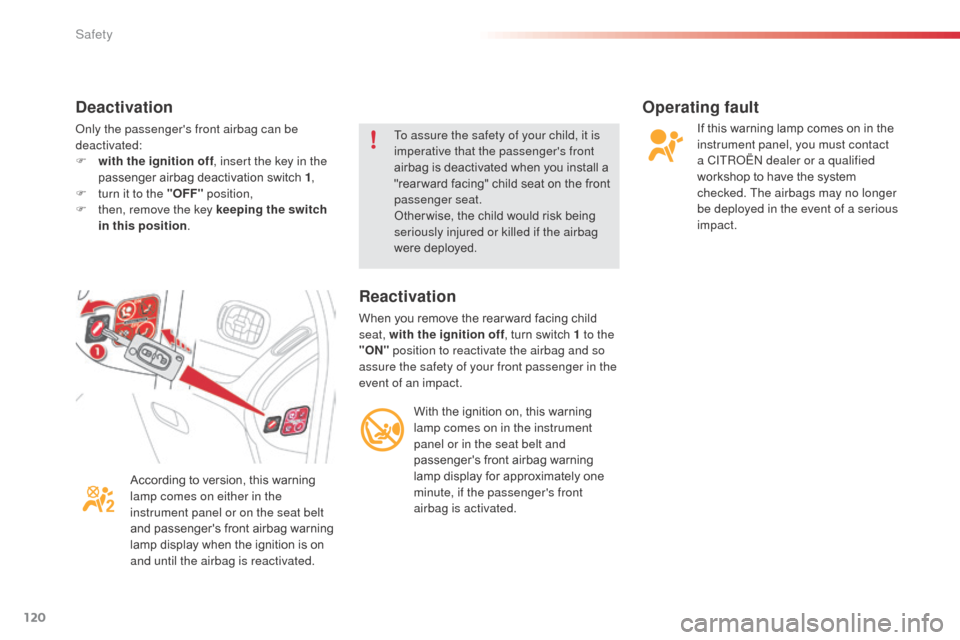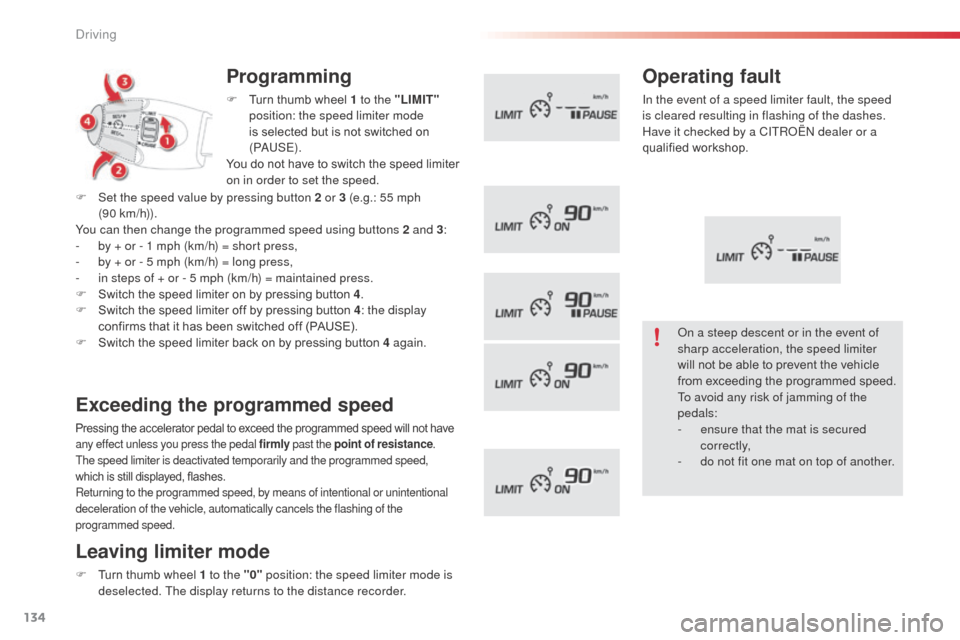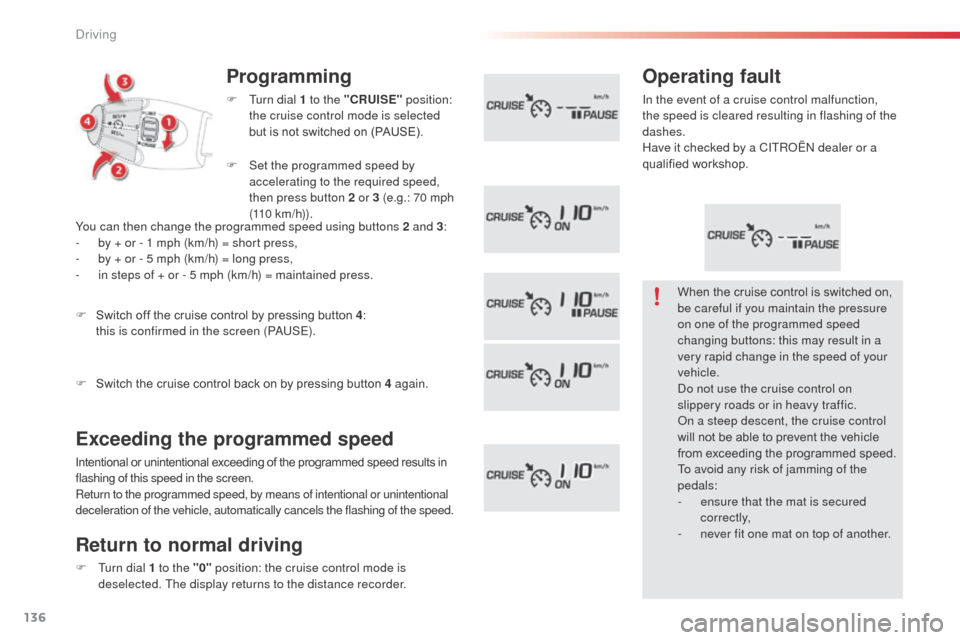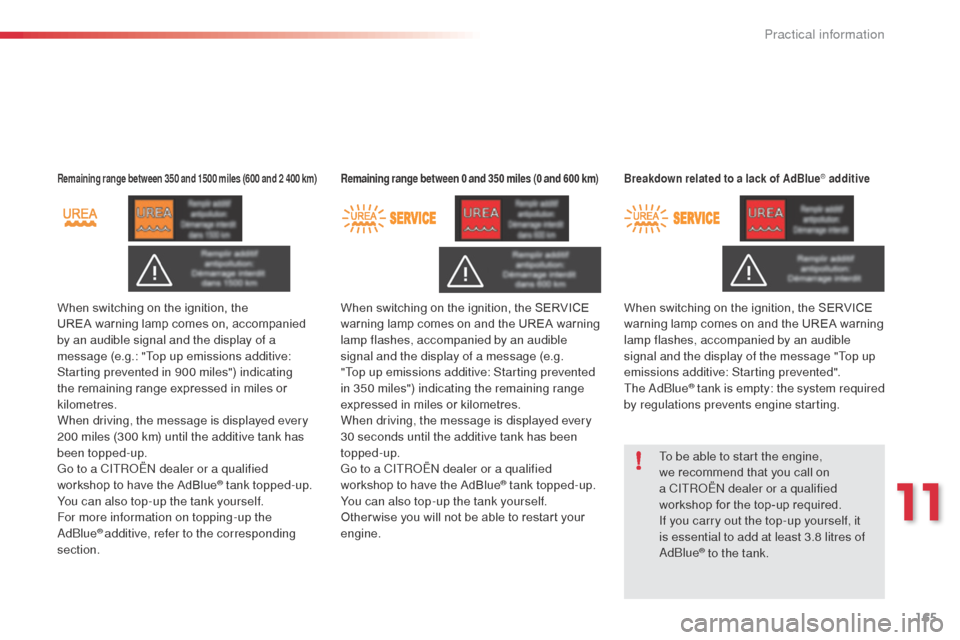display Citroen C3 PICASSO 2016 1.G Owner's Guide
[x] Cancel search | Manufacturer: CITROEN, Model Year: 2016, Model line: C3 PICASSO, Model: Citroen C3 PICASSO 2016 1.GPages: 292, PDF Size: 8.23 MB
Page 119 of 292

117
C3Picasso_en_Chap08_securite_ed01-2015
2nd row rear centre seat belt
Removal and storing
F Press the red button on the buckle B, then on the buckle A .
F
G
uide the strap as it rolls up and bring the
tongue B , then A
onto the magnet of the
attachment point on the roof.
Installation
F Pull the strap and insert the tongue A in the left-hand buckle.
F
I
nsert the tongue B in the right-hand
buckle.
F
C
heck the fastening of each buckle by
pulling the strap.
The seat belt for the rear centre seat of the
2
nd row is incorporated at the rear left of the roof.
Seat belt unfastened warning
lamp display
When the ignition is switched on, the
corresponding warning lamps
4, 5 and 6 come
on in red for approximately 30 seconds, if the
seat belt is not fastened.
When the engine is running or the vehicle is
moving, the corresponding warning lamp 4, 5 or
6 comes on in red, accompanied by an audible
signal and a message on the multifunction
screen, if a rear passenger has unfastened
their seat belt.
8
Safety
Page 122 of 292

120
C3Picasso_en_Chap08_securite_ed01-2015
Operating fault
If this warning lamp comes on in the
instrument panel, you must contact
a CITROËN dealer or a qualified
workshop to have the system
checked. The airbags may no longer
be deployed in the event of a serious
impact.
Reactivation
When you remove the rear ward facing child
seat, with the ignition off, turn switch 1 to the
"ON" position to reactivate the airbag and so
assure the safety of your front passenger in the
event of an impact.
With the ignition on, this warning
lamp comes on in the instrument
panel or in the seat belt and
passenger's front airbag warning
lamp display for approximately one
minute, if the passenger's front
airbag is activated.
According to version, this warning
lamp comes on either in the
instrument panel or on the seat belt
and passenger's front airbag warning
lamp display when the ignition is on
and until the airbag is reactivated.
Deactivation
Only the passenger's front airbag can be
deactivated:
F
w
ith the ignition off , insert the key in the
passenger airbag deactivation switch 1 ,
F
t
urn it to the "OFF" position,
F
t
hen, remove the key keeping the switch
in this position . To assure the safety of your child, it is
imperative that the passenger's front
airbag is deactivated when you install a
"rear ward facing" child seat on the front
passenger seat.
Other wise, the child would risk being
seriously injured or killed if the airbag
were deployed.
Safety
Page 130 of 292

128
C3Picasso_en_Chap09_conduite_ed01-2015
Display in the instrument panel
N. Neutral
R. R everse
1, 2, 3, 4, 5, 6. Gears in manual mode.
AUTO.
T
his comes on when the automated
mode is selected. It switches off on
changing to manual mode.
Moving off
F Select position N .
F P ress the brake pedal down fully.
F
S
tart the engine.N appears in the instrument panel
screen.
F
Sel
ect automated mode (position A ) or
manual mode (position M) or reverse
(position R ).
AUTO and 1, 1 or R appear in the instrument
panel screen.
F
R
elease the parking brake.
F
P
rogressively take your foot off the brake
pedal.
F
A
ccelerate away.
Automated mode
F Select position A .
AUTO and the gear engaged appear
in the instrument panel screen.
The gearbox operates in auto-active mode,
without any action on the part of the driver. It
continuously selects the most suitable gear for:
-
o
ptimisation of fuel consumption,
-
t
he style of driving,
-
t
he profile of the road.
-
t
he vehicle load.
For optimum acceleration, for example
when overtaking another vehicle, press the
accelerator pedal firmly past the point of
resistance.
Do not press the brake and accelerator
pedals at the same time. There would
be a risk of rapid wear of the clutch. Never select neutral N when driving.
If the engine does not start:
-
If N flashes in the instrument
panel, move the gear selector to
position
A , then to position N .
-
I
f the message " Foot on the
brake " is displayed in the screen,
accompanied by an audible signal,
press the brake pedal firmly.
You can change mode at any time by
moving the gear selector from A to M or
the other way round.
Driving
Page 135 of 292

133
C3Picasso_en_Chap09_conduite_ed01-2015
Speed limiter
The controls of this system are grouped
together on stalk A.
1.
S
peed limiter mode selection thumb wheel.
2.
V
alue decrease button.
3.
V
alue increase button.
4.
S
peed limiter on / off button. The programmed information is grouped
together in the instrument panel screen.
5.
S
peed limiter on / off indication.
6.
Spe
ed limiter mode selection indication.
7.
P
rogrammed speed value.
Steering mounted controlsDisplays in the instrument panel
The speed limiter is switched on manually:
it requires a programmed speed of at least
20
mph (30 km/h).
The speed limiter is switched off by manual
operation of the control.
The programmed speed can be exceeded
temporarily by pressing the accelerator firmly.
To return to the programmed speed, simply
slow down to a speed below the programmed
speed.
The programmed speed remains in the memory
when the ignition is switched off.
The speed limiter cannot, in any circumstances,
replace the need to respect speed limits, nor can it
replace the need for vigilance on the part of the driver.
System which prevents the vehicle from
exceeding the speed programmed by the driver.
When the programmed speed limit is reached,
pressing the accelerator pedal in the normal
manner no longer has any effect.
9
Driving
Page 136 of 292

134
C3Picasso_en_Chap09_conduite_ed01-2015
Programming
F Turn thumb wheel 1 to the "LIMIT"
position: the speed limiter mode
is selected but is not switched on
(PAUS E).
You do not have to switch the speed limiter
on in order to set the speed.
Exceeding the programmed speed
Pressing the accelerator pedal to exceed the programmed speed will not have
any effect unless you press the pedal firmly past the point of resistance.
The speed limiter is deactivated temporarily and the programmed speed,
which is still displayed, flashes.
Returning to the programmed speed, by means of intentional or unintentional
deceleration of the vehicle, automatically cancels the flashing of the
programmed speed.
Leaving limiter mode
F Turn thumb wheel 1 to the "0" position: the speed limiter mode is
deselected. The display returns to the distance recorder.
Operating fault
In the event of a speed limiter fault, the speed
is cleared resulting in flashing of the dashes.
Have it checked by a CITROËN dealer or a
qualified workshop.
F
S
et the speed value by pressing button 2 or 3 (e.g.: 55 mph
(90
km/h)).
You can then change the programmed speed using buttons 2 and 3 :
-
b
y + or - 1 mph (km/h) = short press,
-
b
y + or - 5 mph (km/h) = long press,
-
i
n steps of + or - 5 mph (km/h) = maintained press.
F
S
witch the speed limiter on by pressing button 4 .
F
S
witch the speed limiter off by pressing button 4 : the display
confirms that it has been switched off (PAUSE).
F
S
witch the speed limiter back on by pressing button 4 again. On a steep descent or in the event of
sharp acceleration, the speed limiter
will not be able to prevent the vehicle
from exceeding the programmed speed.
To avoid any risk of jamming of the
pedals:
-
e
nsure that the mat is secured
c o r r e c t l y,
-
d
o not fit one mat on top of another.
Driving
Page 137 of 292

135
C3Picasso_en_Chap09_conduite_ed01-2015
System which automatically maintains the
speed of the vehicle at the value programmed
by the driver, without any action on the
accelerator pedal.The controls of this system are grouped
together on control stalk A.The programmed information is grouped
together in the instrument panel screen.Steering mounted controlsDisplays in the instrument panel
The cruise control is switched on
manually: it
requires a minimum vehicle speed of 25 mph
(40 km/h) and the engaging of at least 4th gear.
The cruise control is switched off manually
or by pressing the brake or clutch pedal or
on triggering of the ESP system for safety
reasons.
It is possible to exceed the programmed speed
temporarily by pressing the accelerator pedal.
To return to the programmed speed, simply
release the accelerator pedal.
Switching off the ignition cancels any
programmed speed value. 1.
C
ruise control mode selection thumb whee;
2.
S
peed programming / value decrease
button
3.
S
peed programming / value increase
button
4.
C
ruise control off / resume button5.
C
ruise control off / resume indication
6.
C
ruise control mode selection indication
7.
P
rogrammed speed value
The cruise control cannot, in any circumstances,
replace the need to respect speed limits, nor can it
replace the need for vigilance on the part of the driver.
Cruise control
9
Driving
Page 138 of 292

136
C3Picasso_en_Chap09_conduite_ed01-2015
Programming
F Turn dial 1 to the "CRUISE" position:
the cruise control mode is selected
but is not switched on (PAUSE).
Exceeding the programmed speed
Intentional or unintentional exceeding of the programmed speed results in
flashing of this speed in the screen.
Return to the programmed speed, by means of intentional or unintentional
deceleration of the vehicle, automatically cancels the flashing of the speed.
Return to normal driving
F Turn dial 1 to the "0" position: the cruise control mode is
deselected. The display returns to the distance recorder.
Operating fault
In the event of a cruise control malfunction,
the speed is cleared resulting in flashing of the
dashes.
Have it checked by a CITROËN dealer or a
qualified workshop.
F
S
et the programmed speed by
accelerating to the required speed,
then press button 2 or 3 (e.g.: 70 mph
(110 km/h)).
F
S
witch off the cruise control by pressing button 4 :
this is confirmed in the screen (PAUSE).
F
S
witch the cruise control back on by pressing button 4 again.
You can then change the programmed speed using buttons 2 and 3
:
-
b
y + or - 1 mph (km/h) = short press,
-
b
y + or - 5 mph (km/h) = long press,
-
i
n steps of + or - 5 mph (km/h) = maintained press. When the cruise control is switched on,
be careful if you maintain the pressure
on one of the programmed speed
changing buttons: this may result in a
very rapid change in the speed of your
vehicle.
Do not use the cruise control on
slippery roads or in heavy traffic.
On a steep descent, the cruise control
will not be able to prevent the vehicle
from exceeding the programmed speed.
To avoid any risk of jamming of the
pedals:
-
e
nsure that the mat is secured
c o r r e c t l y,
-
n
ever fit one mat on top of another.
Driving
Page 166 of 292

164
C3Picasso_en_Chap11_informations-pratiques_ed01-2015
Range indicators
Once the AdBlue® tank is on reserve or after
detection of a fault with the SCR emissions
control system, when the ignition is switched
on, an indicator displays an estimate of the
distance that can be covered, the range, before
engine starting is prevented.
In the event of simultaneous system fault and
low AdBlue
® level, the shortest range figure is
the one displayed.
In the event of the risk of
non-starting related to a lack
of AdBlue
®
The engine start prevention system
required by regulations is activated
automatically once the AdBlue
® tank is
e m pt y.
Range greater than 1 500 miles (2 400 km)
When the ignition is switched on, no
information on range is displayed automatically
in the instrument panel.
For more information on topping-
up the AdBlue® additive, refer to the
corresponding section.
Practical information
Page 167 of 292

165
C3Picasso_en_Chap11_informations-pratiques_ed01-2015
Remaining range between 350 and 1500 miles (600 and 2 400 km)
When switching on the ignition, the
UREA warning lamp comes on, accompanied
by an audible signal and the display of a
message (e.g.: "Top up emissions additive:
Starting prevented in 900 miles") indicating
the remaining range expressed in miles or
kilometres.
When driving, the message is displayed every
200 miles (300 km) until the additive tank has
been topped-up.
Go to a CITROËN dealer or a qualified
workshop to have the AdBlue
® tank topped-up.
You can also top-up the tank yourself.
For more information on topping-up the
AdBlue
® additive, refer to the corresponding
section.
Remaining range between 0 and 350 miles (0 and 600 km)
When switching on the ignition, the SERVICE
warning lamp comes on and the UREA warning
lamp flashes, accompanied by an audible
signal and the display of a message (e.g.
"Top up emissions additive: Starting prevented
in 350 miles") indicating the remaining range
expressed in miles or kilometres.
When driving, the message is displayed every
30 seconds until the additive tank has been
topped-up.
Go to a CITROËN dealer or a qualified
workshop to have the AdBlue
® tank topped-up.
You can also top-up the tank yourself.
Other wise you will not be able to restart your
engine. When switching on the ignition, the SERVICE
warning lamp comes on and the UREA warning
lamp flashes, accompanied by an audible
signal and the display of the message "Top up
emissions additive: Starting prevented".
The AdBlue
® tank is empty: the system required
by regulations prevents engine starting.
Breakdown related to a lack of AdBlue® additive
To be able to start the engine,
we recommend that you call on
a CITROËN dealer or a qualified
workshop for the top-up required.
If you carry out the top-up yourself, it
is essential to add at least 3.8 litres of
AdBlue
® to the tank.
11
Practical information
Page 168 of 292

166
C3Picasso_en_Chap11_informations-pratiques_ed01-2015
In the event of a fault with the the SCR emissions control system
A system that prevents engine starting is activated automatically from 650 miles (1 100 km) after confirmation of a fault with the SCR emissions control
system. Have the system checked by a CITROËN dealer or a qualified workshop as soon as possible.You have exceeded the authorised
driving limit: the starting prevention
system inhibits engine starting.
If it is a temporary fault, the alert
disappears during the next journey,
after self-diagnosis of the SCR system.
The UREA, SERVICE and diagnostic warning
lamps comes on, accompanied by an audible
signal and the display of the message
"Emissions fault".
The alert is triggered when driving when the
fault is detected for the first time, then when
switching on the ignition for subsequent
journeys, while the fault persists. In the event of the detection of a fault
If a fault with the SCR system is confirmed (after
30
miles (50 km) covered with the permanent display
of the message signalling a fault), the SERVICE and
engine diagnostic warning lamps come on and the
UREA warning lamp flashes, accompanied by an
audible signal and the display of a message (e.g.:
"Emissions fault: Starting prevented in 150 miles")
indicating the remaining range express in miles or
kilometres.
While driving, the message is displayed every
30
seconds while the fault with the SCR system
persists.
The alert is repeated when switching on the ignition.
You should go to a CITROËN dealer or a qualified
workshop as soon as possible.
Other wise, you will not be able to restart your engine.
During an authorised driving phase (between
650 miles and 0 miles) (1 100 km and 0 km)
Every time the ignition is switched on, the
SERVICE and engine diagnostic warning
lamps come on and the UREA warning lamp
flashes, accompanied by an audible signal and
the display of the message "Emissions fault:
Starting prevented". Starting prevented
To be able to start the engine, you must call on
a CITROËN dealer or a qualified workshop.
Practical information